Maths Olympiad Model Test Papers -3 | Maths Olympiad Class 6 PDF Download
| Table of contents |

|
| Logical Reasoning |

|
| Mathematical Reasoning |

|
| Everyday Mathematics |

|
| Achievers Section |

|
Note: The questions provided in this document are similar to the questions that were asked in the actual Olympiad exam. So, we recommend you study these for your Olympiad preparation
Logical Reasoning
Q1: Introducing Aman, Kritika says, "The mother of his daughter is the sole daughter of my father's wife." How is Kritika connected to Aman?
(a) Sister
(b) Sister-in-law
(c) Wife
(d) Cousin
 View Answer
View Answer 
Ans: (c)
- Kritika refers to "my father's wife," which is her mother.
- Since she mentions "the only daughter," it indicates that Kritika is the daughter of her mother.
- This means Kritika is the wife of Aman, as she is the mother of his daughter.
- Thus, Kritika is related to Aman as his wife.
Q2: Arrange the following words in the order they would appear in a dictionary and choose the correct option.
1. Feminine
2. Feature
3. Feeding
4. Fenestration
5. Feather
(a) 5, 2, 3, 4, 1
(b) 2, 5, 3, 4, 1
(c) 5, 2, 1, 3, 4
(d) 5, 2, 3, 1, 4
 View Answer
View Answer 
Ans: (d)
- To arrange the words in dictionary order, we look at the first letter of each word.
- The first word starting with 'F' is Feather (5), followed by Feature (2), then Feeding (3), and Fenestration (4).
- Finally, Feminine (1) comes last as it starts with 'F' but is alphabetically after the others.
- Thus, the correct order is 5, 2, 3, 1, 4, which corresponds to option (d).
Q3: If ‘+’ represents ‘division’, ‘–’ signifies ‘addition’, ‘×’ indicates ‘subtraction’, and ‘÷’ means ‘multiplication’, what is the result of 18 – 12 + 6 ÷ 2 × 5?
(a) 17
(b) 25
(c) 15
(d) 13
 View Answer
View Answer 
Ans: (a)
- First, replace the symbols according to the given definitions: 18 + 12 ÷ 6 × 5.
- Next, perform the operations in the correct order: division first, then multiplication.
- Calculate 12 ÷ 6 = 2, then 2 × 5 = 10.
- Finally, add 18 + 10 = 28, but since we have to subtract 12, we do 28 - 12 = 17.
Q4: Identify the number that does not belong in the group.
(a) 13
(b) 15
(c) 21
(d) 28
 View Answer
View Answer 
Ans: (a)
- The question asks to find the odd one out among the numbers listed.
- All the numbers except 13 are composite numbers, meaning they have more than two factors.
- 13 is a prime number, which only has two factors: 1 and 13 itself.
- Thus, 13 is the only number that does not fit with the others in this context.
Q5: If the digits of the following numbers are flipped and then the numbers are sorted in descending order, what will be the total of the digits of the second number?
(a) 20
(b) 21
(c) 11
(d) 25
 View Answer
View Answer 
Ans: (b)
- First, reverse the digits of each number provided.
- Next, arrange these reversed numbers in descending order.
- Identify the second number in this ordered list.
- Finally, calculate the sum of its digits to find the answer.
Q6: The bar graph shows the sale of chocolates in 5 months from January to May: What is the total sale of chocolates from January to May? (a) 3000
(a) 3000
(b) 3800
(c) 4000
(d) 4500
 View Answer
View Answer 
Ans: (b)
Q7: How many of the following figures have exactly one line of symmetry?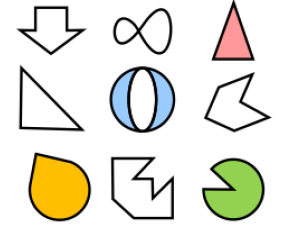 (a) 5
(a) 5
(b) 6
(c) 7
(d) 8
 View Answer
View Answer 
Ans: (d)
Q8: The portion of a circle bounded by a chord and the arc subtended by the chord is called ____________ of a circle.
(a) Sector
(b) Segment
(c) Radius
(d) Diameter
 View Answer
View Answer 
Ans: (b)
Q9: How many lines of symmetry are there in an equilateral triangle?
(a) 0
(b) 1
(c) 2
(d) 3
 View Answer
View Answer 
Ans: (d)
Q10: If a train travels 60 km in 1 hour, how far will it travel in 3.5 hours?
(a) 180 km
(b) 200 km
(c) 210 km
(d) 220 km
 View Answer
View Answer 
Ans: (c)
The train travels 60 km per hour, so in 3.5 hours it will travel 60 × 3.5 = 210 km.
Q11: A rectangle has a length of 8 cm and a width of 5 cm. What is its perimeter?
(a) 26 cm
(b) 30 cm
(c) 40 cm
(d) 45 cm
 View Answer
View Answer 
Ans: (b)
Perimeter of a rectangle is 2 × (length + width) = 2 × (8 + 5) = 26 cm.
Q12: If the sum of two numbers is 30 and one of the numbers is 12, what is the other number?
(a) 15
(b) 18
(c) 12
(d) 20
 View Answer
View Answer 
Ans: (b)
The other number is 30 – 12 = 18.
Q13: If a book has 240 pages and you read 30 pages every day, how many days will it take to finish the book?
(a) 6
(b) 7
(c) 8
(d) 9
 View Answer
View Answer 
Ans: (c)
It will take 240 ÷ 30 = 8 days to finish the book.
Q14: What is the average of these numbers:
6, 8, 10, 12?
(a) 8
(b) 9
(c) 10
(d) 11
 View Answer
View Answer 
Ans: (c)
The average is (6 + 8 + 10 + 12) ÷ 4 = 36 ÷ 4 = 9.
Q15: A box contains 20 red balls and 30 blue balls. What is the ratio of red balls to blue balls?
(a) 2 : 3
(b) 1 : 1
(c) 2 : 5
(d) 3 : 5
 View Answer
View Answer 
Ans: (a)
The ratio of red balls to blue balls is 20:30, which simplifies to 2:3.
Mathematical Reasoning
Q16: Determine the value of m, given that the numbers m, 24, 72, and 96 are in proportion.
(a) 12
(b) 36
(c) 18
(d) 26
 View Answer
View Answer 
Ans: (c)
- To find m, we use the property of proportions, which states that the product of the means equals the product of the extremes.
- Here, we set up the equation: m * 96 = 24 * 72.
- Calculating the right side: 24 * 72 = 1728.
- Now, we have m * 96 = 1728, so m = 1728 / 96 = 18.
- Thus, the value of m is 18, confirming that the numbers are in proportion.
Q17: By how much is two-fifths of 125 less than three-eighths of 256?
(a) 52
(b) 46
(c) 58
(d) 42
 View Answer
View Answer 
Ans: (b)
- First, calculate two-fifths of 125: (2/5) * 125 = 50.
- Next, calculate three-eighths of 256: (3/8) * 256 = 96.
- Now, find the difference: 96 - 50 = 46.
- Thus, two-fifths of 125 is 46 less than three-eighths of 256.
Q18: The area of a rectangle is 49 cm². If its breadth is 2.8 cm, then find its perimeter.
(a) 40.6 cm
(b) 42.4 cm
(c) 38.6 cm
(d) 46.4 cm
 View Answer
View Answer 
Ans: (a)
- To find the perimeter of the rectangle, we first need to determine its length.
- Using the formula for the area of a rectangle, Area = Length × Breadth, we can rearrange it to find Length: Length = Area / Breadth.
- Substituting the values: Length = 49 cm² / 2.8 cm = 17.5 cm.
- Now, we can calculate the perimeter using the formula: Perimeter = 2 × (Length + Breadth).
- So, Perimeter = 2 × (17.5 cm + 2.8 cm) = 2 × 20.3 cm = 40.6 cm.
Q19: Which of the following shapes has all the faces the same?
(a) Square Pyramid
(b) Triangular Prism
(c) Cube
(d) Sphere
 View Answer
View Answer 
Ans: (c)
- The cube is a three-dimensional shape where all six faces are squares and are identical in size and shape.
- In contrast, a square pyramid has a square base and triangular faces, while a triangular prism has two triangular bases and rectangular sides.
- A sphere is a round shape with no faces at all, making it different from the cube.
- Thus, the only shape with all identical faces is the cube.
Q20: Calculate the total of all odd factors of 42.
(a) 31
(b) 11
(c) 32
(d) 34
 View Answer
View Answer 
Ans: (c)
- To find the odd factors of 42, we first determine its prime factorization: 42 = 2 × 3 × 7.
- We ignore the factor of 2 since we are only interested in odd factors.
- The odd factors come from the product of the remaining prime factors: 3 and 7.
- The odd factors of 42 are: 1, 3, 7, and 21. Adding these gives us 1 + 3 + 7 + 21 = 32.
Q21: Which of the following is equivalent to ( 0.004/0.4 + 0.4/0.004 )?
(a) 10.001
(b) 100.1
(c) 100.01
(d) 10.01
 View Answer
View Answer 
Ans: (c)
- To solve the expression, first calculate 0.004/0.4, which equals 0.01.
- Next, calculate 0.4/0.004, which equals 100.
- Now, add the two results: 0.01 + 100 = 100.01.
- Thus, the final answer is 100.01, which corresponds to option (c).
Q22: If x = 30, y = 40, and z = 8, what is the result of x ÷ (y ÷ z)?
(a) 25
(b) 5
(c) 6
(d) 4
 View Answer
View Answer 
Ans: (c)
- To solve for x ÷ (y ÷ z), first calculate y ÷ z.
- Here, y = 40 and z = 8, so 40 ÷ 8 = 5.
- Now, substitute this back into the equation: x ÷ 5 where x = 30.
- Thus, 30 ÷ 5 = 6, which is the final answer.
Q23: Which of the following properties is illustrated in the equation 3 × (7 + 5) = (3 × 7) + (3 × 5)?
(a) Closure
(b) Commutative
(c) Distributive
(d) Identity
 View Answer
View Answer 
Ans: (c)
- The equation demonstrates the Distributive Property, which states that multiplying a number by a sum is the same as multiplying that number by each addend and then adding the results.
- In this case, 3 is distributed to both 7 and 5 inside the parentheses.
- This property is essential in simplifying expressions and solving equations.
- Closure, Commutative, and Identity properties do not apply to this specific equation.
Q24: The sum of all the factors of a perfect number is ________ the number.
(a) Twice
(b) Equal to
(c) Half of
(d) Can’t be determined
 View Answer
View Answer 
Ans: (a)
- The definition of a perfect number is that it is equal to the sum of its proper divisors (excluding itself).
- For example, the number 6 is a perfect number because its factors are 1, 2, and 3, and 1 + 2 + 3 = 6.
- When you include the number itself, the sum of all factors becomes twice the perfect number.
- Thus, the correct answer is that the sum of all factors of a perfect number is twice the number itself.
Q25: Subtract the total of 23.456 and 18.75 from 98.735 and round the result to the nearest hundredths.
(a) 56.52
(b) 56.53
(c) 56.50
(d) 56.529
 View Answer
View Answer 
Ans: (b)
- First, calculate the sum of 23.456 and 18.75, which equals 42.206.
- Next, subtract this sum from 98.735: 98.735 - 42.206 = 56.529.
- Finally, round 56.529 to the nearest hundredths, which gives you 56.53.
- Thus, the correct answer is (b) 56.53.
Q26: The perpendicular bisector of a line segment is a perpendicular to the line segment that divides it into ________ parts.
(a) Two unequal
(b) Three unequal
(c) Three equal
(d) Two equal
 View Answer
View Answer 
Ans: (d)
- The perpendicular bisector is a line that cuts another line segment into two equal parts at a 90-degree angle.
- This means that the two segments created by the bisector are of equal length.
- Thus, the correct answer is that it divides the line segment into two equal parts.
- Options (a), (b), and (c) are incorrect because they suggest unequal or more than two parts.
Q27: Examine the following statements and choose the accurate option.
P: The Roman numeral V can only be subtracted from X.
Q: The smallest 4-digit number that can be created using the digits 1, 4, 0, and 9 without repeating any digit is 1409.
(a) Both P and Q are true.
(b) Both P and Q are false.
(c) Only P is true.
(d) Only Q is true.
 View Answer
View Answer 
Ans: (b)
- Statement P is false because V can also be subtracted from other Roman numerals, not just X.
- Statement Q is also false since the smallest 4-digit number formed by the digits 1, 4, 0, and 9 is actually 1049, not 1409.
- Thus, both statements are incorrect, leading to the conclusion that the correct answer is option (b).
Q28: Which of the following is best represented by the integer -50?
(a) Price of mangoes is increased by ₹50 per kg.
(b) Size of a shape is enlarged by 50%.
(c) A submarine is 50 km below sea level.
(d) The height of the tower is 50 feet below sea level.
 View Answer
View Answer 
Ans: (c)
- The integer -50 indicates a negative value, which is often used to represent something below a reference point.
- In this case, a submarine being 50 km below sea level is the correct interpretation of -50, as it signifies depth.
- The other options either represent positive changes or heights above sea level, which do not align with the negative integer.
- Thus, the correct answer is that the submarine's position is best represented by -50.
Q29: Determine the value of p in the equation 2p – p/3 = 35.
(a) 5
(b) 3
(c) 15
(d) 21
 View Answer
View Answer 
Ans: (d)
- To solve the equation 2p – p/3 = 35, first, we need to eliminate the fraction. We can do this by multiplying the entire equation by 3.
- This gives us 6p - p = 105 (since 3 * 35 = 105).
- Now, combine like terms: 5p = 105.
- Next, divide both sides by 5 to find p = 21.
Q30: Product of a number by 3 is equal to 171 then the number is:
(a) 53
(b) 63
(c) 57
(d) 97
 View Answer
View Answer 
Ans: (c)
The product of a number by 3 is equal to 171.
3x = 171
x = 171/3 = 57 ⇒ x = 57
Q31: Find the number which when multiplied by 12 gives 36.
(a) 3
(b) 8
(c) 4
(d) 12
 View Answer
View Answer 
Ans: (a)
The number which when multiplied by 12 gives 36
12 × x=36x
x = 36/12 = 3
Q32: The point that lies in the interior of ∠SOP is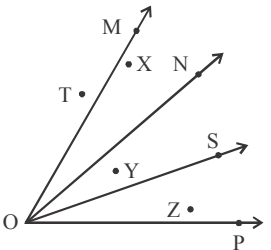 (a) X
(a) X
(b) Z
(c) Y
(d) T
 View Answer
View Answer 
Ans: (b)
The point Z lies in the interior of ∠SOP.
Q33: How many triangles are there in the figure?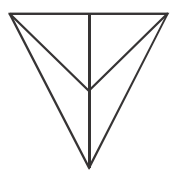 (a) 4
(a) 4
(b) 8
(c) 7
(d) 5
 View Answer
View Answer 
Ans: (b)
Q34: Look at the given figure and note that no 3 points are collinear points. The maximum number of triangles that can be formed by using any 3 points is ___________.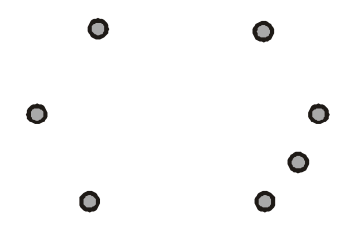 (a) 35
(a) 35
(b) 40
(c) 25
(d) 30
 View Answer
View Answer 
Ans: (a)
Q35: The number of angles in the figure is (a) 3
(a) 3
(b) 4
(c) 5
(d) 6
 View Answer
View Answer 
Ans: (d)
Everyday Mathematics
Q36: Mrs. Sharma has a monthly income of ₹45000. After spending ₹38750, she saves the remaining amount. What is the ratio of her savings to her total income?
(a) 4 : 35
(b) 6 : 35
(c) 7 : 36
(d) 5 : 36
 View Answer
View Answer 
Ans: (d)
- Mrs. Sharma's total income is ₹45000.
- Her total spending is ₹38750.
- To find her savings, subtract spending from income: ₹45000 - ₹38750 = ₹6250.
- The ratio of her savings to her income is 6250 : 45000, which simplifies to 5 : 36.
Q37: A scientist took two samples. He froze one sample at –39°C and the other at –62°C. What is the temperature difference between these two samples?
(a) 31°C
(b) 23°C
(c) –23°C
(d) –31°C
 View Answer
View Answer 
Ans: (b)
- To find the temperature difference, subtract the lower temperature from the higher temperature.
- The higher temperature is –39°C and the lower temperature is –62°C.
- Calculating this gives: –39°C - (–62°C) = –39°C + 62°C = 23°C.
- Thus, the temperature difference between the two samples is 23°C.
Q38: 950 crankcases are produced daily in a factory. If the factory operates every day during the months of October, November, and December, how many crankcases will be produced in total during these three months?
(a) 83700
(b) 85400
(c) 84700
(d) 87400
 View Answer
View Answer 
Ans: (d)
- The total number of days in October, November, and December is 31 + 30 + 31 = 92 days.
- Daily production is 950 crankcases.
- To find the total production, multiply the daily production by the total number of days: 950 * 92 = 87400.
- Thus, the total number of crankcases manufactured in these three months is 87400.
Q39: The floor of a room with dimensions 15 m and 13 m is to be covered with square tiles. If each square tile is of side 25 cm, then find the number of tiles required.
(a) 3240
(b) 3040
(c) 2860
(d) 3120
 View Answer
View Answer 
Ans: (d)
- First, calculate the area of the room: 15 m * 13 m = 195 m2.
- Convert the area to square centimeters: 195 m2 = 1,950,000 cm² (since 1 m² = 10,000 cm2).
- Next, find the area of one tile: (25 cm)2 = 625 cm2.
- Finally, divide the total area of the room by the area of one tile: 1,950,000 cm2 / 625 cm2 = 3120 tiles.
Q40: Sneha has ₹40x. She spent ₹250 on food, ₹75y on clothes, ₹375 on travel, and received ₹1500 as a birthday gift. How much money is left with her?
(a) ₹(40x + 75y – 875)
(b) ₹(40x – 75y + 875)
(c) ₹(40x – 75y – 875)
(d) ₹(40x + 25y + 845)
 View Answer
View Answer 
Ans: (b)
- To find out how much money Sneha has left, we start with her total amount, which is ₹40x.
- She spent ₹250 on food, ₹75y on clothes, and ₹375 on travel, totaling ₹(250 + 75y + 375) = ₹(625 + 75y).
- She also received ₹1500 as a birthday gift, so we add this to her total.
- The final calculation for the money left is: ₹40x + ₹1500 - (₹625 + 75y) = ₹(40x - 75y + 875).
Q41: A milkman delivers 28 litres of milk to a community in the morning and 36 litres in the evening. If the price of milk is ₹62 per litre, what is the total amount of money the milkman makes in a day?
(a) ₹3246
(b) ₹4242
(c) ₹3968
(d) ₹3846
 View Answer
View Answer 
Ans: (c)
- First, calculate the total milk supplied: 28 litres in the morning + 36 litres in the evening = 64 litres.
- Next, find the total earnings by multiplying the total litres by the cost per litre: 64 litres × ₹62 = ₹3968.
- Thus, the milkman earns ₹3968 in a day from selling milk.
Q42: Sarthak purchased  meters of ribbon, while Saumya acquired
meters of ribbon, while Saumya acquired  meters of ribbon. Who has more ribbon and by what amount?
meters of ribbon. Who has more ribbon and by what amount?
(a) Sarthak, 11/72 m
(b) Sarthak, 13/72 m
(c) Saumya, 11/72 m
(d) Saumya, 13/72 m
 View Answer
View Answer 
Ans: (a)
- To determine who bought more ribbon, we need to compare
 m and
m and  m.
m. - First, convert both mixed numbers to improper fractions:
 = 99/8 and
= 99/8 and  = 110/9.
= 110/9. - Next, find a common denominator (which is 72) to compare the two fractions: 99/8 = 891/72 and 110/9 = 880/72.
- Since 891/72 is greater than 880/72, Sarthak bought more ribbon by 11/72 m.
Q43: The population of a city in the year 2019 was 3546253. Round off the population to the nearest ten thousands.
(a) 3540000
(b) 3550000
(c) 3546000
(d) 3500000
 View Answer
View Answer 
Ans: (b)
- To round off the number 3546253 to the nearest ten thousand, we look at the digit in the thousands place, which is 6.
- Since 6 is greater than or equal to 5, we round up the ten thousand place from 4 to 5.
- This means that 3546000 becomes 3550000 when rounded to the nearest ten thousand.
- Thus, the rounded population is 3550000.
Q44: Deepak had 17.45 litres of water. After giving 8.30 litres to his neighbour, how much water does he have left?
(a) 9.30 litres
(b) 5.45 litres
(c) 9.15 litres
(d) 5.82 litres
 View Answer
View Answer 
Ans: (c)
- To find out how much water Deepak has left, we need to subtract the amount he gave away from the total he had.
- He started with 17.45 litres and gave away 8.30 litres.
- So, we calculate: 17.45 - 8.30 = 9.15 litres.
- This means Deepak has 9.15 litres of water remaining.
Q45: Find the value of y from the given figure.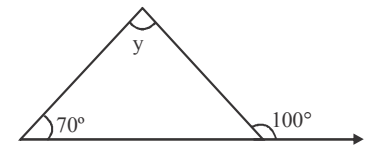 (a) 30°
(a) 30°
(b) 100°
(c) 170°
(d) 80°
 View Answer
View Answer 
Ans: (a)
70°+y=100°
y=100°-70° =30°
Achievers Section
Q46: Examine the statements below and choose the accurate option. Enclosed by an arc and a chord.
Statement-1: A chord of a circle is a line segment connecting any two points on the circle.
Statement-2: A segment of a circle is a region within the circle.
(a) Both Statement-1 and Statement-2 are false.
(b) Both Statement-1 and Statement-2 are true.
(c) Statement-1 is true but Statement-2 is false.
(d) Statement-1 is false but Statement-2 is true.
 View Answer
View Answer 
Ans: (b)
- Statement-1 is true because a chord indeed connects any two points on the circle.
- Statement-2 is also true as a segment of a circle refers to the area enclosed by a chord and the arc connecting its endpoints.
- Both statements accurately describe properties of a circle, making option (b) the correct choice.
- Understanding these definitions is essential for grasping basic circle geometry.
Q47: The number of times an observation is repeated in a data is called
(a) Frequency
(b) Sample
(c) Pie chart
(d) None of these
 View Answer
View Answer 
Ans: (a)
Q48: When it become tedious to represent data by pictograph, we go to represent data by
(a) Bar graph
(b) Line graph
(c) Tally marks
(d) None of these
 View Answer
View Answer 
Ans: (a)
Q49: A rectangular room is 10 m wide and 6 m high. If the area of its four walls is 540 m2, then its length will be
(a) 40m
(b) 70m
(c) 45m
(d) 35m
 View Answer
View Answer 
Ans: (d)
Area of room = 540 m2
2(l+b) h=540
Q50: Think of an even number 2x, then the next odd number is
(a) 2x-1
(b) 2x+1
(c) 2x+2
(d) 2x-2
 View Answer
View Answer 
Ans: (b)
|
30 videos|120 docs|59 tests
|
FAQs on Maths Olympiad Model Test Papers -3 - Maths Olympiad Class 6
| 1. What topics are covered in the Class 6 Maths Olympiad Model Test Papers? |  |
| 2. How can I prepare effectively for the Class 6 Maths Olympiad? |  |
| 3. Are there any specific strategies for solving Logical Reasoning questions in the Olympiad? |  |
| 4. What is the importance of Everyday Mathematics in the Class 6 Maths Olympiad? |  |
| 5. How do Olympiad scores benefit students in their academic journey? |  |















